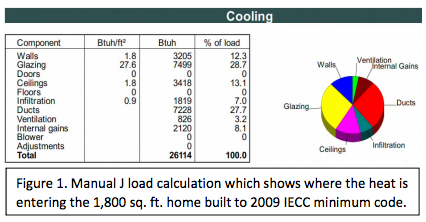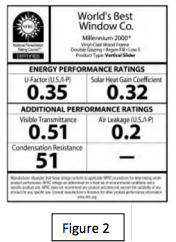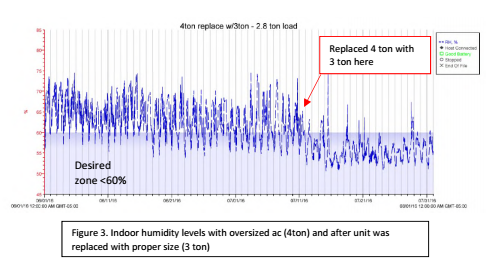Is your ac company asking the right questions?
During a recent conference call with approximately 25-30 builders around the US, a conversation
arose concerning how to control the relative humidity in buildings. With me, an a/c guy on the call, of course I immediately went into proper ac sizing. After what seemed like only a few seconds of explaining to the group all the variables that go into properly sizing an a/c unit for a building, one of the builders stopped me and made a profound statement. “Bobby, he said, builders don’t want to know how to properly size an air conditioner BUT… they do want to know that their a/c guy does!”
With this in mind, how does a builder know that his a/c guy is doing thing correctly? To start with, is he asking you the right questions? A building is a complex puzzle with many pieces so let’s look at how each piece affects the building.
 Figure 1 is a look at an approximately 1,800 square foot home built to the 2009 IECC minimum code which Louisiana is currently operating under. This is a conventionally insulated home with Low E windows, R30 attic and R6 ducts located in the attic space. It has brick cladding with R13 wall insulation and is facing in the worst-case orientation… and this is just a few things you need to know about this home. Let’s break it down starting with the weakest point.
Figure 1 is a look at an approximately 1,800 square foot home built to the 2009 IECC minimum code which Louisiana is currently operating under. This is a conventionally insulated home with Low E windows, R30 attic and R6 ducts located in the attic space. It has brick cladding with R13 wall insulation and is facing in the worst-case orientation… and this is just a few things you need to know about this home. Let’s break it down starting with the weakest point.
The windows
 Many times the window information is the hardest for me to get from a builder and it really shouldn’t be. Every window comes with a white sticker with the information I need. The most important number for us, in the south, is the Solar Heat Gain Coefficient (SHGC) and with glazing (fancy word for windows) accounting for 28.7% of the cooling load, I need to get it right! This number tells us just how good the window is and the lower the number, the better the window. The Uo Factor is also needed but effects us, again… in the south, slightly less than the SHGC.
Many times the window information is the hardest for me to get from a builder and it really shouldn’t be. Every window comes with a white sticker with the information I need. The most important number for us, in the south, is the Solar Heat Gain Coefficient (SHGC) and with glazing (fancy word for windows) accounting for 28.7% of the cooling load, I need to get it right! This number tells us just how good the window is and the lower the number, the better the window. The Uo Factor is also needed but effects us, again… in the south, slightly less than the SHGC.
Next, let’s talk ductwork
What dummy would ever decide to take the coldest air in the building and then circulate it through the hottest cavity of the building (somewhere between 3-5 times an hour). Surely not someone who understands thermodynamics (hot moves to cold and the greater the difference between the two, the faster it moves) because that’s among the worst things we could do when trying to cool a home. However, 80% or more of the homes being built today are designed this way. Notice that this is the second largest heat gain in the cooling load at 27.7%, almost as much as the windows. This is why foam insulation, on the bottom of the roof decking (encapsulated attics) is more energy efficient, it brings the ductwork inside the thermal barrier of the home and the ducts are no longer circulating air through a 150 plus degree attic.
Other ways of achieving similar results would be to upgrade the duct insulation to R8 instead of R6 and using a radiant barrier roof decking. In many cases, mainly smaller homes, the results are very similar to spray foam at a much lower cost. But, you have to do the calculations to know for sure!
In the previous example home used in Figure 1, if we increase the duct from R6 to R8, use a radiant barrier roof decking and decrease the SHGC from .40 (2009 IECC) down to .25 (2015 IECC) minimum, we can eliminate approximately 22% of the sensible cooling load and 1⁄2 ton of a/c size. This equates to a more comfortable home and a lower light bill by decreasing the duct load by almost 40% and the window load by 26%.
The wall, ceiling and other
The importance of these areas should not be overlooked however not nearly as critical as the previously discussed items. In this building, the windows and ducts originally accounted for 56.4% of the cooling load while all other components combined make up the remaining 43.6%. Questions like what direction is the home facing? Are the walls brick or vinyl siding, 2×4 or 2×6 and what R value of insulation will be used are very important? Although relatively smaller items individually, they add up quickly.
Just how important is using the proper size a/c?
As we construct our building tighter and insulate better, getting the a/c size correct is the single most important thing we do to control indoor humidity. Elevated indoor humidity is one of the largest contributors to poor indoor air quality, lower thermostat settings and higher light bills.
To demonstrate this importance, we have monitored the actual ambient conditions inside the living areas of many homes. Figure 3 below is an illustration of one such case. The Manual J load calculations for this home indicated a cooling load of 2.8 ton (which means that a 3 ton would be the appropriate size).
However, the a/c guy thinking bigger is better of course, installed a 4 ton system. The humidity was remaining consistently above 60%Rh. Within only days of replacing the 4 ton with a properly sized 3 ton, the humidity dropped into the desired zone of <60%.
Summary
If you’re a/c company is not discussing where the ducts are to be located and what R value will be used. If they are not requiring you to provide the Uo and SHGC of the windows, then they are not doing the calculation. If they are not asking questions like, what direction is the front door facing and what are the insulation levels being used throughout the structure, then they are not doing the calculations.
So… Mr./Ms. Builder, please be patient and help us lowly a/c guys out. Please don’t get irritated because we are asking so many questions. We’re just trying to do you a good job by doing ours correctly.
For more information click on the “HVAC Info Request” Form. Here you will find the questions we ask our customers to answer, so we can complete the proper load calculations and designs.

